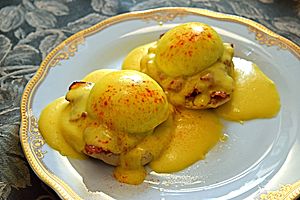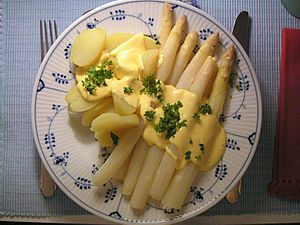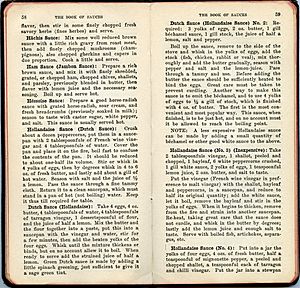Hollandaise sauce facts for kids

Mustard-flavored hollandaise sauce served as part of eggs Benedict with a dash of paprika
|
|
| Type | Sauce |
|---|---|
| Place of origin | France, the Netherlands |
| Main ingredients | Egg yolk, liquid butter, lemon juice |
Hollandaise sauce is a creamy, rich sauce that's a big part of French cuisine. It's made by mixing egg yolks, melted butter, and lemon juice. Sometimes, a little white wine or vinegar is used instead of lemon juice. Chefs often add salt and a pinch of white pepper or cayenne pepper for flavor.
Hollandaise is special because it's one of the five "mother sauces" in French cooking. This means it's a basic sauce from which many other sauces can be made. You might know it best as a key ingredient in eggs Benedict, a popular breakfast dish. It's also delicious served over steamed vegetables like asparagus.
Contents
Where Hollandaise Sauce Comes From
The name Sauce hollandaise is French for "Dutch sauce." This makes it sound like it came from the Netherlands, but its true origin isn't totally clear. People have used the name "Dutch sauce" in English since at least 1573. However, the first known recipe that sounds like modern hollandaise sauce appeared in a French cookbook in 1651.
This cookbook, called Le Cuisinier François, was written by François Pierre La Varenne. His recipe for "asparagus with fragrant sauce" said to:
- Make a sauce with fresh butter.
- Add a little vinegar, salt, and nutmeg.
- Use an egg yolk to thicken the sauce.
- Be careful not to let it curdle (clump up).
La Varenne is famous for changing how sauces were made after the Middle Ages. Many people think he might have invented hollandaise sauce. Later, in the 1800s, another name for it, sauce Isigny, appeared. This name comes from Isigny-sur-Mer, a French town known for its excellent butter.
In the 19th century, famous chefs like Marie-Antoine Carême and Auguste Escoffier helped classify sauces. Escoffier added hollandaise to his list of the five main "mother sauces" of haute cuisine (fancy French cooking). Some chefs, like Prosper Montagné, suggested adding a white wine or vinegar reduction to the sauce. This can make the flavor even better, similar to a Béarnaise sauce.
How to Make Hollandaise Sauce
Hollandaise sauce is an emulsion. This means it's a stable mix of two liquids that usually don't mix, like oil and water. In hollandaise, the lecithin in egg yolks helps the butter and lemon juice mix together smoothly without separating.
To make it, you gently heat beaten egg yolks with butter, lemon juice, salt, and a little water. Many cooks use a double boiler to keep the temperature just right. This is important because if the sauce gets too hot, it can curdle (clump up). Some chefs also start by reducing (boiling down) vinegar, water, and peppercorns. They strain this mixture and add it to the egg yolks for extra flavor.
Main Ingredients
The basic ingredients for hollandaise sauce are:
- Butter
- Egg yolks
- Lemon juice
- Salt
- White peppercorns (or white pepper)
- Vinegar
- Water
- Cayenne pepper
Other Sauces from Hollandaise
Since hollandaise is a "mother sauce," it's the base for many other delicious sauces. Here are a few examples:
- Sauce Béarnaise is a very common one. It's made by adding a special reduction of vinegar, shallots, fresh chervil, and fresh tarragon to hollandaise. Béarnaise is often served with steak or grilled meats and fish.
- Sauce Choron is like Béarnaise but without tarragon or chervil, and with added tomato purée.
- Sauce Foyot (or Valois) is Béarnaise with meat glaze added.
- Sauce Maltaise is hollandaise with blanched orange zest and the juice of blood oranges.
- Sauce Mousseline (also called sauce Chantilly) is hollandaise with whipped cream folded in, making it lighter and fluffier.
- Sauce Dijon (also known as sauce moutarde) is hollandaise with Dijon mustard added.
See also
 In Spanish: Salsa holandesa para niños
In Spanish: Salsa holandesa para niños



